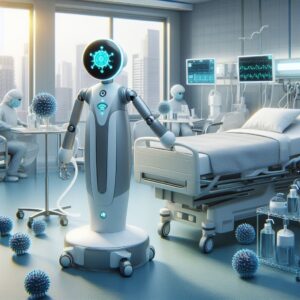Introduction:
In the ever-evolving landscape of healthcare, the integration of robotics has become a transformative force. Hygiene robotics, specifically designed to enhance infection control measures, are revolutionizing the way healthcare facilities manage cleanliness and hygiene. In this article, we’ll explore the innovative applications of hygiene robotics in healthcare facilities and their impact on maintaining a safe and sanitized environment.
Autonomous Cleaning Robots:
Autonomous cleaning robots equipped with advanced sensors and artificial intelligence are taking on the task of maintaining hygiene in healthcare settings. These robots navigate through facilities, detecting and eliminating potential sources of contamination. From automated floor cleaners to UV-C light robots that disinfect surfaces, these machines significantly reduce the reliance on human labor for routine cleaning tasks.
UV-C Disinfection Robots:
UV-C light has proven germicidal properties, effectively neutralizing bacteria and viruses. This designed to autonomously navigate through hospital rooms, surgical suites, and other critical areas. This technology offers an additional layer of protection against healthcare-associated infections, enhancing overall patient safety.
Robotic Hand Hygiene Systems:
Maintaining proper hand hygiene among healthcare professionals is a critical aspect of infection control. Robotic hand hygiene systems are designed to automate and monitor the handwashing process. These systems use sensors to ensure that healthcare workers follow proper hand hygiene protocols, providing real-time feedback and contributing to a culture of cleanliness within the facility.
Mobile Telepresence Robots:
Telepresence robots equipped with cameras and audio systems enable remote communication between healthcare providers and patients or colleagues. These robots allow healthcare professionals to remotely assess patients, participate in consultations. By reducing the need for direct contact, these robots contribute to infection prevention measures.
Robotic Sterilization of Medical Instruments:
Ensuring the sterilization of medical instruments is paramount in preventing infections. Robotic systems are being employed for the efficient cleaning, disinfection, and sterilization of medical tools. These robots can handle intricate tasks with precision, ensuring that medical instruments are thoroughly sanitized before reuse, contributing to the overall safety of healthcare practices.
Automated Linen Management:
Maintaining clean and sanitized linens is crucial in healthcare settings. Robots are being utilized for automated linen management, including the sorting, washing, and distribution of linens throughout the facility. This reduces the risk of contamination and ensures that healthcare providers have access to clean linens when needed.
Challenges and Integration Considerations:
While hygiene robotics offer significant advantages, their integration into healthcare facilities is not without challenges. Ensuring seamless collaboration between robotic systems and human staff, addressing privacy concerns, and navigating complex environments are among the challenges that healthcare facilities must consider when implementing hygiene robotics.
Future Implications and Advancements:
As technology continues to advance, the capabilities of hygiene robotics in healthcare facilities are likely to expand. Innovations in artificial intelligence, sensor technology, and robotics will contribute to the development of more sophisticated and efficient systems, further enhancing infection control measures and improving overall patient outcomes.
Conclusion:
Hygiene robotics in healthcare facilities represent a pivotal advancement in infection control, leveraging automation and precision to create safer and cleaner environments. From autonomous cleaning robots to UV-C disinfection systems, these technologies play a crucial role in reducing the risk of infections and enhancing the overall quality of healthcare delivery. As robotics continue to evolve, their integration into healthcare practices holds the promise of a future.
For more Article like this, visit our Website Here

